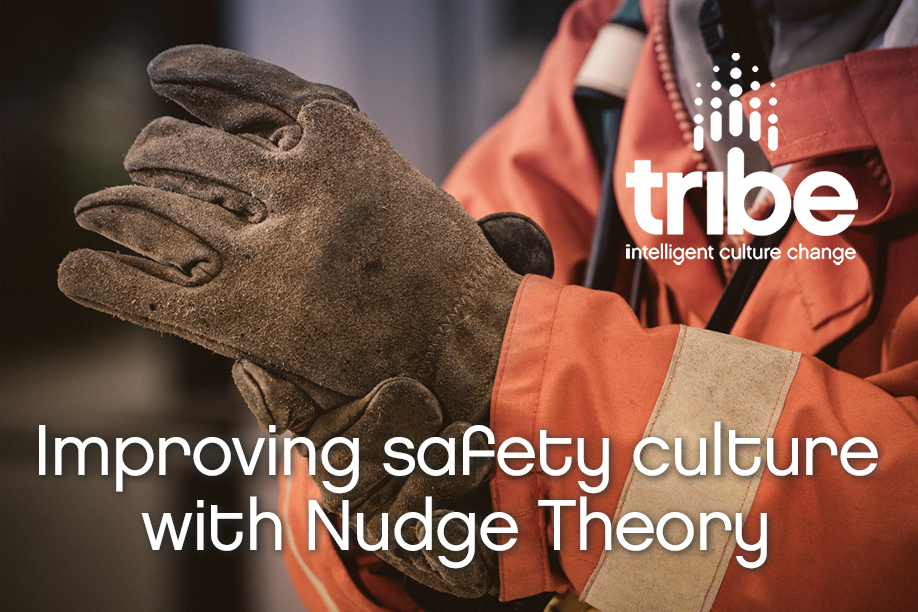
Improving safety culture with Nudge Theory
 Our lead consultant Sarah Prince recently spoke with SHP online (link to article – at bottom of page) to discuss how companies can use Nudge Theory to influence employees into making safer decisions, and ultimately, save lives.
Our lead consultant Sarah Prince recently spoke with SHP online (link to article – at bottom of page) to discuss how companies can use Nudge Theory to influence employees into making safer decisions, and ultimately, save lives.
Did you know that on average we make approximately 35,000 decisions a day? While there are obvious choices such as what to wear and what to eat, we also unconsciously make a number of decisions on autopilot known as habit. But what if peoples’ unconscious behaviours negatively impact a work environment? The consequences can be fatal.
Understanding Behaviour
This is where, as Tribe’s Lead Consultant and Behavioural Expert, I work with companies as part of their ongoing Safety Culture programme. Through considering current behaviours, this information can then be used to influence employees into making the right decision, otherwise known as Nudge Theory.
Behaviour is just a reaction to the environment. It can be an individual’s internal environment, such as how our brain interprets something. For example, if we set goals and targets, what does our brain do? How does it look at those goals? What becomes the most important thing for each person or task?
But beyong this, a number of other factors impact the reasons behind our decisions known as bias, such as upbringing and cultural background. Our external drives – our education, our environment our peer group – also drive our behaviour. And if we have always done something a certain way, why would we need to change it?
Company Culture
But in a business where people are the biggest resource power, decisions being made and how a team works together can produce negative results. This will then impact a working environment where risks could be taken and people’s lives affected. Safety has to be a core value of a company so it becomes part of the everyday.
When a financial director is talking about budgets then questions should be asked how it impacts health and safety. When a production or operation team and setting a new production rate, how does that impact upon the health and safety of the workforce? It’s always about linking it back to the workforce and how it will impact them – but it has to be on all levels of the organisation and in all departments.
The health and safety team facilitates the change and the discussions, but it’s the leadership team from all departments who need to be talking about it on a daily basis.
 Leadership skills
Leadership skills
As a leader, it is imperative to lead by example and pave the way for your team, in turn inspiring them to follow your behaviours. Leadership commitment is the most important thing. If the managing director or chief executive is interested, so will the next level of directors. When you have their interest and they are accountable to deliver a goal, the next tier down will then show an interest.
But when managing a wide number of different personalities (with their own internal and external reactions to an environment) encouraging the right decisions can be tricky.
When I think about changing behaviours in a work environment, I consider their role. What is a supervisor’s role? Or a manager’s role? What kind of peers are being put together? Choosing that workforce correctly is important as well as setting up a work environment to make it easier to achieve a goal or a set of guidance.
Nudge Theory
So, how can a leader ‘nudge’ someone to make an alternative decision? If you put some fruit on a tray, cut up and sliced, or alternatively a packet of biscuits, yes, there are biscuits but there is also some really nice fruit prepared and ready to grab. This makes it easier for people to choose the healthier option. You are still giving people the opportunity to make the decision for themselves, but the better decision from a health perspective, is an easier choice.
Culture Change
However, it takes more than just a one-time choice. Current research suggests it takes over two months and up to 10,000 notions for something to become an instinctive habit. 99 per cent of the time people don’t make mistakes or do the wrong thing because they are being malicious. They are usually doing it with the right reason in mind, to please somebody, to get a task done quicker or they are under pressure.
Our brain will take the quickest route which is already set up within our neural pathways. Think of a really dense forest with trees in your way but there is already a path weaving its way through, that everybody takes – this is the path of least resistance but what if it actually leads us to an incident? We need to cut down a new pathway. That is then your new neural pathway, your new connection – but if you don’t keep going down that route, it will simply grow back, and the old route will get taken again.
Within a Safety environment
Statistics show that human error is responsible for anywhere between 70-100% of workplace safety incidents. So how do we make this neural pathway (the right decision) become commonplace behaviour? If you are working with chemicals, and a chemical storage unit is on one side and the PPE storage the other, and you ask someone to get a solvent out to degrease something – you go to the chemical store, you come back, and they have to then go and get the PPE. Alternatively, if the PPE for that particular chemical was stored next to it, people are more likely to wear the PPE than make the unsafe decision to not. Once again, you are giving people the opportunity to do the right thing. It is ready for them. All they have to do is put it on.
The power of communication
 While it is important for safety culture to start at the top, how it is then communicated to the rest of the organisation creates the biggest long-term impact. If employees think they are being heard, they are going to engage more. There is no point in asking people to fill out ‘near misses’ and then never feed back as they will just think no one is listening. Health and safety has got to be made interesting and not just process driven.
While it is important for safety culture to start at the top, how it is then communicated to the rest of the organisation creates the biggest long-term impact. If employees think they are being heard, they are going to engage more. There is no point in asking people to fill out ‘near misses’ and then never feed back as they will just think no one is listening. Health and safety has got to be made interesting and not just process driven.
Through listening to the concerns of the workforce and what might be causing them to act in a certain way, and then by constantly drip-feeding information and new ideas through the organisation, people’s neural pathways will start to connect.
People will then start to see on their own accord that this is where they need to be heading and lives will be saved.
About Sarah Prince
Lead Consultant
Sarah’s main passion lies in looking at culture through a holistic lens, understanding what drives behaviour and using psychological models of behaviour to help organisations improve their safety culture. She’s led safety culture change programmes for more than a decade and holds an MSc in the Psychology of Behaviour Change in Health and Safety.
Specialisms: Leadership and employee engagement, Behaviour change psychology
Industry experience Construction, Manufacturing, Oil and Gas, Quarrying



